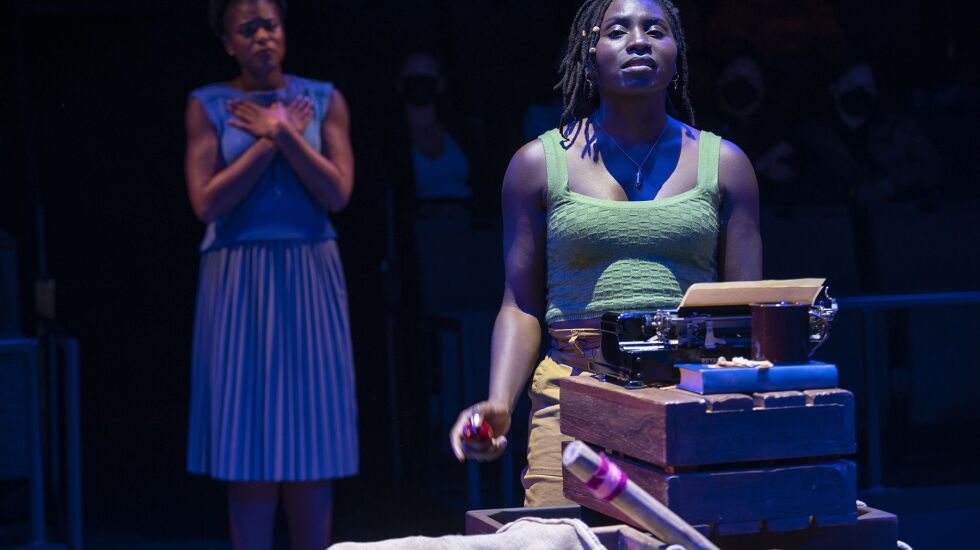
Eve L. Ewing’s poetry collection “1919,” published a century after the year of its title, looks back at and forward from the summer of 1919 to tell a story of how Black lives are lived in Chicago. Playwright J. Nicole Brooks’ new world premiere adaptation, now on stage at Steppenwolf Theatre Company, brings Ewing’s interweaving of research and imagination to thrilling, kinetic life.
Ewing, for those unfamiliar, is a public scholar and a faculty member at the University of Chicago, as well as a bit of a literary rock star, acclaimed as a writer of nonfiction, poetry, and even work for Marvel Comics (most prominently as a writer of the Chicago-based teen superhero Ironheart, soon to make her Marvel Cinematic Universe debut in “Black Panther: Wakanda Forever”).
“1919” was born out of Ewing’s research for “Ghosts in the Schoolyard: Racism and School Closings on Chicago’s South Side,” her 2018 book about the wave of Chicago Public Schools closures under former Mayor Rahm Emanuel. Ewing came across a 1922 report commissioned by former Illinois Gov. Frank Lowden titled “The Negro in Chicago: A Study of Race Relations and a Race Riot.”
The report, produced by a hand-picked commission of 12 appointees — six Black men and six white — was a kind of post-mortem of the dayslong race riots that had left 38 people dead and hundreds injured in the summer of 1919. The Chicago riot was one of many such events taking place across the country during that so-called Red Summer.
Here, the clash was precipitated by the drowning murder of Eugene Williams, a Black teenager who allegedly drifted across an imaginary boundary in the water while swimming in Lake Michigan, thus encroaching on an unofficially whites-only section of beach. Black witnesses accused white men of throwing stones at the boy in the water resulting in his drowning, but a police officer on the scene refused to make an arrest.
Fascinated by the 1922 report’s attempts to not just establish a timeline and record of the riots, but to put the events in the context of the present and historical state of relations between Black and white Chicagoans, Ewing took passages from the study as prompts for many of the poems in “1919,” which like “The Negro in Chicago” looks back to the Great Fire and the Great Migration. Ewing also brings the timeline forward to include Emmett Till and Harold Washington and the deadly heat wave of 1995.
Looking at this kaleidoscopic portrait of Black life in this city, you imagine the most daunting step for the adept adapter Brooks (“Her Honor Jane Byrne” at Lookingglass Theatre) was finding a place to begin. She finds it, appropriately enough, in the character of a writer (Sola Thompson) struggling with the enormity of her task.

Thompson — in whose unnamed character you could choose to see Ewing, Brooks, or an amalgamation thereof — is soon visited by five more actors, outfitted by costume designer Gregory Graham to suggest various eras of the last century. Thompson’s writer dubs them her muses, giving them names like “the griever,” “the challenger” and “the wise one.”
These six actors then become the vessels for Ewing’s words — with additions from Brooks that touch on even more recent events. The ensemble — which includes Sheldon D. Brown, Jessica Dean Turner, Max Thomas, DeMorris Burrows and Alexis Ward — is as deft with Ewing’s linguistic flourishes as it is with the muscular physicality of the staging. Co-directors Gabrielle Randle-Bent and Tasia A. Jones make satisfying use of Steppenwolf’s new, in-the-round Ensemble Theater to create an immersive audience experience.
Many of this show’s audiences, it should be noted, will be made up of high school students on field trips, as “1919” is produced under the theater’s invaluable Steppenwolf for Young Adults banner (although, to be clear, this engrossing production is a must-see for grown-ups, too). There’s a popular argument in American politics right now that says this sort of frank discussion of racism and its dangers is too advanced for teenagers to have in school. Eugene Williams, forever 17, suggests otherwise.







